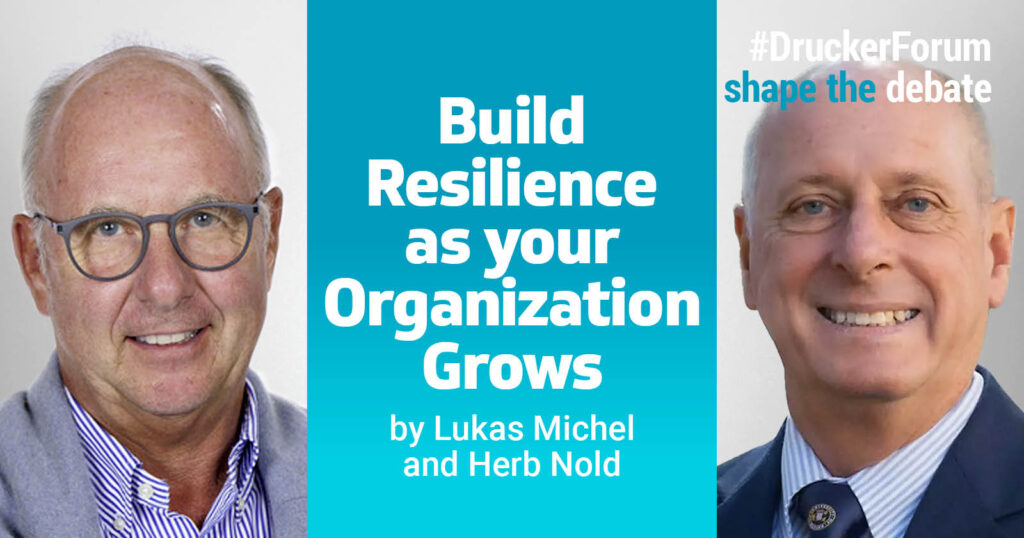
You know the situation. You have seemingly done nothing different, but suddenly notice that your leadership is less effective, your culture signals infections, and your management system keeps you busy rather than serving your business. It is very likely that these are the early symptoms of a systemic crisis that is about to hit your organization. That crisis is a natural part of your growth cycle. Your organization simply is ready for the transition to the next phase of its development. The task is to build the resilience that enables your organization to continue to grow.
The growth life cycle model. Greiner’s (1998) widely cited original model, published in 1972 and expanded upon in 1997, suggested that the life cycle of an organization follows five distinct stages. Each has an evolutionary growth phase and a revolutionary crisis phase that must be overcome before the organization can advance and continue to grow.
Entrepreneurial organizations have a design and management style that promotes innovation, creativity, and speed. Direct personal engagement between the founders and employees provides motivation and adequate management direction informally. Success and growth create the crisis of leadership, which must be resolved to continue successful growth.
The company has grown in scope and complexity thanks to entrepreneurial success. Functional organizations are created with professional managers to oversee specific functions or divisions under directive leadership by senior executives. The second crisis of autonomy mounts as functional or divisional managers compete for resources and recognition while being controlled by the directives from the cadre of senior executives.
Decentralized organizations delegate accountability to managers of sub-units, plants, markets, or geographies. This independence and freedom to act encourages unit managers to employ people-centric methodologies and improves responsiveness to the customer or market. Business unit managers develop and implement processes and systems to measure performance and report to headquarters. Top management at the home office begins to sense a loss of effective oversight, and the crisis of control has arrived.
Segment organizations require coordination by top management through a sophisticated control mechanism. Complex webs of processes, procedures and policies evolve, intended keep headquarters executives informed on what is going on in the segments, so they can step in with corrective actions if the segment wanders from the corporate strategy. Burdensome approval processes degrade responsiveness and stifle innovation. The crisis of red tape arises with increasing size and complexity as the home office attempts to coordinate the various segments through processes and procedures.
Complexity increases, leading to the development of matrix and network organizations that require interaction among the members to collaborate and get things done. Members in the emerging alliances or ecosystems may be external organizations. Consequently, the crisis of sovereignty will emerge.
Three stopes to resilience and growth
Our research on 400 organization over 10 years has revealed three generic steps leaders can adopt to build resilience and continue to grow. Understanding the underlying attributes of the organization in its current growth stage is the first step. Identifying strengths that can be leveraged and weaknesses to be strengthened is the second step. Taking focused action, taking advantage of strengths, eliminating weaknesses, and building essential capabilities becomes the key third step to advance to the next growth state.
Four transition strategies
We have identified four transition strategies to help managers build essential capabilities to overcome the limiting crisis and advance down the path to growth. These are: people first, people-centric management, dynamic operations, and agile organization. These general strategies are not mutually exclusive. They should be blended and adapted to meet the unique needs of the organization. To guide the organization through the transition dedicated structures, systems and capabilities help to resolve the natural tension between evolution and revolution.
The need for resilience.
The digital economy accelerates the pace of change and organizational development. Organizations advance through growth life cycle stages quicker and experience crisis more often. Using the life cycle framework, managers can identify potential roadblocks and build resilience with people-centric, agile and dynamic capabilities before crisis hits. With advance warning of impending problems, executives can implement strategies to help navigate the impending storm before it hits. Embedding people-centric dynamic capabilities into the organization enables it to absorb the disruptive shock, react quickly, and emerge with stronger resilience to weather the storm.
Be ready for the transition
Business leaders should be aware of which stage their organization is in, the characteristics of the current stage, and the characteristics of the next stage. Successfully and seamlessly navigating an organization from one stage to another is a challenge for even the most talented leaders. To successfully move from one to the next, top executives and entrepreneurs should be aware of what actions must be taken in advance to make a seamless transition. Leaders should proactively prepare for these transitions by laying the foundations or infrastructure needed to prevent a crisis that inhibits further growth. A clear understanding and appreciation of the growth framework helps managers proactively manage the development of their organization.
Bibliography: Greiner, L. E. (1998). Evolution and Revolution as Organizations Grow. Harvard Business Review: Mai-June.
About the Authors:
Lukas Michel is the founder of Management Insights, Switzerland, and author of several management books.
Herb Nold is a Professor of Business Administration at Polk State College, USA, and author.
Their latest book: THE TRANSITION OF ORGANIZATIONS: Managing for growth at each stage of the organization’s life-cycle. LID Publishing, 2023, London.

